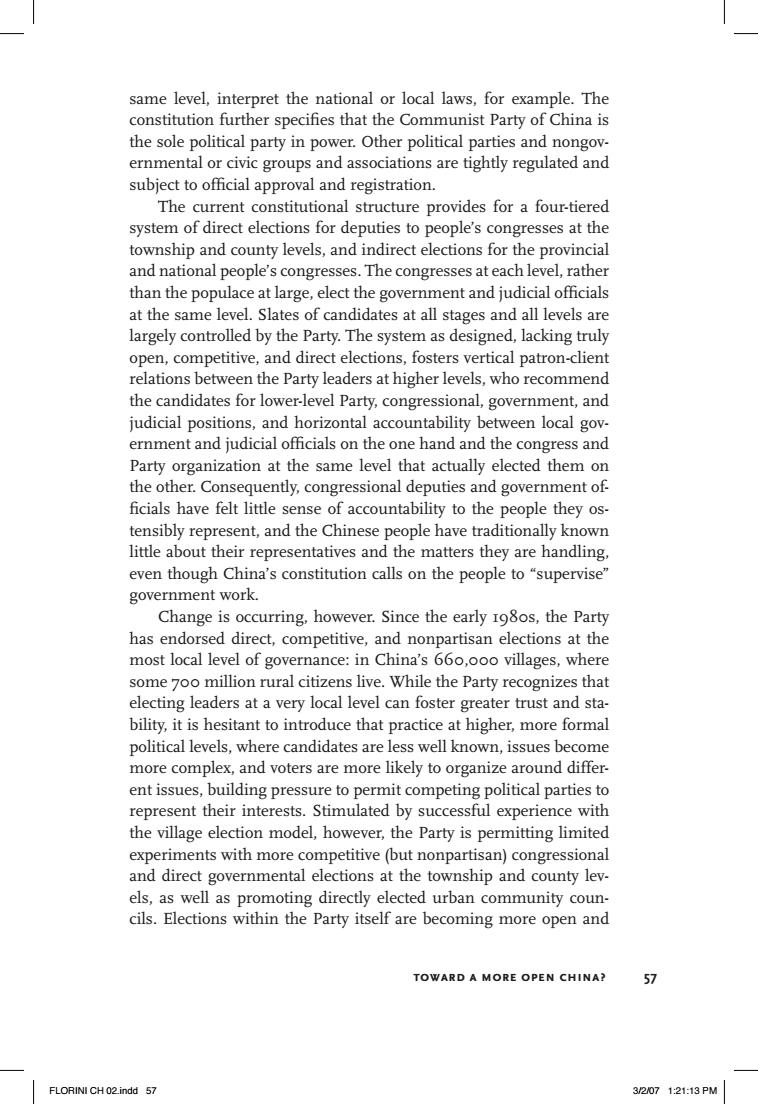正在加载图片...

same level,interpret the national or local laws,for example.The constitution further specifies that the Communist Party of China is the sole political party in power.Other political parties and nongov- ernmental or civic groups and associations are tightly regulated and subject to official approval and registration. The current constitutional structure provides for a four-tiered system of direct elections for deputies to people's congresses at the township and county levels,and indirect elections for the provincial and national people's congresses.The congresses at each level,rather than the populace at large,elect the government and judicial officials at the same level.Slates of candidates at all stages and all levels are largely controlled by the Party.The system as designed,lacking truly open,competitive,and direct elections,fosters vertical patron-client relations between the Party leaders at higher levels,who recommend the candidates for lower-level Party,congressional,government,and judicial positions,and horizontal accountability between local gov- ernment and judicial officials on the one hand and the congress and Party organization at the same level that actually elected them on the other.Consequently,congressional deputies and government of ficials have felt little sense of accountability to the people they os- tensibly represent,and the Chinese people have traditionally known little about their representatives and the matters they are handling, even though China's constitution calls on the people to "supervise" government work. Change is occurring,however.Since the early Ig8os,the Party has endorsed direct,competitive,and nonpartisan elections at the most local level of governance:in China's 660,ooo villages,where some 7oo million rural citizens live.While the Party recognizes that electing leaders at a very local level can foster greater trust and sta- bility,it is hesitant to introduce that practice at higher,more formal political levels,where candidates are less well known,issues become more complex,and voters are more likely to organize around differ- ent issues,building pressure to permit competing political parties to represent their interests.Stimulated by successful experience with the village election model,however,the Party is permitting limited experiments with more competitive(but nonpartisan)congressional and direct governmental elections at the township and county lev- els,as well as promoting directly elected urban community coun- cils.Elections within the Party itself are becoming more open and TOWARD A MORE OPEN CHINA? 57 FLORINI CH02indd 57 3/2071:21:13PMtoward a more open china? 57 same level, interpret the national or local laws, for example. The constitution further specifies that the Communist Party of China is the sole political party in power. Other political parties and nongovernmental or civic groups and associations are tightly regulated and subject to official approval and registration. The current constitutional structure provides for a four-tiered system of direct elections for deputies to people’s congresses at the township and county levels, and indirect elections for the provincial and national people’s congresses. The congresses at each level, rather than the populace at large, elect the government and judicial officials at the same level. Slates of candidates at all stages and all levels are largely controlled by the Party. The system as designed, lacking truly open, competitive, and direct elections, fosters vertical patron-client relations between the Party leaders at higher levels, who recommend the candidates for lower-level Party, congressional, government, and judicial positions, and horizontal accountability between local government and judicial officials on the one hand and the congress and Party organization at the same level that actually elected them on the other. Consequently, congressional deputies and government officials have felt little sense of accountability to the people they ostensibly represent, and the Chinese people have traditionally known little about their representatives and the matters they are handling, even though China’s constitution calls on the people to “supervise” government work. Change is occurring, however. Since the early 1980s, the Party has endorsed direct, competitive, and nonpartisan elections at the most local level of governance: in China’s 660,000 villages, where some 700 million rural citizens live. While the Party recognizes that electing leaders at a very local level can foster greater trust and stability, it is hesitant to introduce that practice at higher, more formal political levels, where candidates are less well known, issues become more complex, and voters are more likely to organize around different issues, building pressure to permit competing political parties to represent their interests. Stimulated by successful experience with the village election model, however, the Party is permitting limited experiments with more competitive (but nonpartisan) congressional and direct governmental elections at the township and county levels, as well as promoting directly elected urban community councils. Elections within the Party itself are becoming more open and FLORINI CH 02.indd 57 3/2/07 1:21:13 PM